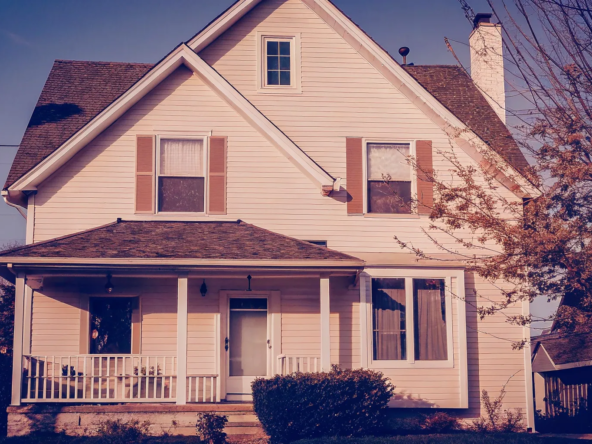When preparing to sell a home, homeowners often ask whether investing in a new roof will increase home value. It’s a question that touches on financial strategy, market appeal, and long-term return. A roof is more than just a top—it’s a shield, a first impression, and a selling point. Buyers notice roofing age, condition, and quality. A well‑installed, attractive, and durable roof offers reassurance that the house is maintained and protected.
Zillow research shows that a new roof can recoup about 60–70 percent of its cost at resale, meaning replacing your roof before selling your home often translates into higher asking prices and less negotiation from buyers. In competitive markets buyers might bypass homes with aging roofs in favor of move‑in ready options with no anticipated repair costs ahead. So how do you decide whether to repair or replace? That’s the focus of this guide.
When to Replace Your Roof: Signs and Criteria
Recognizing the right time to replace your roof is critical. Many homeowners wonder how to know when to replace your roof, and the answer often comes down to age, condition, and look. Roofs generally last 20 to 30 years, depending on materials and installation quality. If you’re selling a house with a 20 year old roof, chances are it’s nearing the end of its useful life. Even if it’s not leaking, roof tiles may be brittle, granule loss might be substantial, and minor issues could turn into costly damages.
Roof needs fixing can show up as curled or buckling shingles, dark streaks from algae, cracked tiles, sagging areas, or flashings around chimneys and vents coming loose. When roof replacement house wide is necessary, the benefits extend beyond preventing leaks. A brand new roof offers better insulation, improved energy efficiency, and can refresh curb appeal significantly.
If you wonder, “Can I get a new roof now and sell?” the answer is yes, and the decision is strategic. Putting on new roof right before listing transforms your property into a standout. Buyers feel confident they’re not inheriting roofing problems, and appraisers may credit the property more if the roof is fresh.
Should I Replace Roof Before Selling? A Strategic Choice
Choosing whether to replace your roof before selling depends on age, inspection findings, market conditions, and your budget. If the roof still has life left—around 5 years—and costs to repair or patch are reasonable, then a well‑executed repair might satisfy both buyer and seller. However if the house roof reaches around 15–20 years old, or repair is frequent and costly, then replacement is often smarter.
When you ask, “Should I replace my roof before selling?” think in terms of return on investment. A new roof can raise appraisal value, strengthen appeal, and reduce buyer negotiation leverage. Conversely, if your roof is newish and healthy, repairing a few problem areas may suffice. Buyers might agree to price adjustments to cover future roof replacement costs, especially if it’s clearly documented and priced out. Make sure to review inspection reports and buyer feedback before proceeding either way.
Calculating ROI on Roof Replacement
Roof replacement can be expensive — average costs vary by roofing material, square footage, access difficulty, and labor rates. Many homeowners wonder how much to replace a small roof or how much should it cost to replace my roof. National averages in recent years range from $7,000 to $12,000 for asphalt shingle roof replacements on average homes. Premium options like metal or slate exceed that. Homeowners often search for roof replacement cost long island or similar areas, but price generally correlates with square footage and material rather than zip code.
So is it worth replacing a roof before selling? Study after study shows you recoup 60–70 percent, sometimes more in hot markets. If it costs $10,000 to replace the roof, you might expect home value to rise by $6,000–$7,000. But that’s baseline. Enhanced curb appeal might lead to a faster sale and fewer concessions—saving time and holding costs. In some cases, a new roof can differentiate your home so well that you command full replacement value or more. That’s especially true if buyers are comparing small roof replacement cost to repair estimates.
Return on investment also depends on material: asphalt shingles are common for a reason—moderate cost and predictable replacement. When budgeting and evaluating ROI, weigh installation cost, material lifespan, and buyer perception. Metal roofs last longer and offer energy savings, but high upfront cost may not be fully recouped in traditional resale.
Repair or Replace Roof Shingles? Timing and Decision Factors
Before jumping to replace, examine whether repairing your roof can solve the problem. Many homeowners ask repair or replace roof shingles? Answer: minor leaks, isolated damaged roofing sections, missing or cracked shingles—these are often good candidates for repair. If your roofer can patch damaged shingles, fix flashing, and seal leaks effectively, it might prevent the need for full replacement and hold value. A well-repaired roof gives buyers peace of mind.
However when the accumulation of repairs – cracked tiles, constant leaks, sagging sections – becomes a pattern, the wise advice is to replace entire roof. A patched roof can appear neglected, and buyers might worry about future issues. So when roof needs repair frequently or major components like decking or flashing are compromised, replacement is the better path to secure value.
Selling a House with a 20 Year Old Roof: Impact and Strategy
If you’re selling a house with a 20 year old roof, items to consider include buyer perception and inspection outcomes. Roof materials like asphalt shingles generally last 20–25 years. At 20 years, they’re nearing end of life. Buyers may ask for replacement or offer a lower purchase price to cover future roof costs. Some inspectors will note missing granules, weathered shingles, or damaged flashing, reducing perceived home value.
To navigate selling with an older roof, you have options. One is to replace your roof before selling, thus eliminating inspection red flags. Another is to offer a priced concession or credit equivalent to the anticipated roof replacement cost. Buyers could accept that if they plan to re-roof later. That said, sellers refusing to replace roof may find local appraisal standards penalize the old roof’s effect on value. A new roof can also improve home listing photo appeal—immediately capturing buyer interest.
How to Replace Your Roof: Process Overview
For homeowners ready to replace your roof, here’s a clear walkthrough of how to replace your roof while preparing to sell. First you schedule inspections and gather contractor quotes. Licensed roofers will assess roofing deck, flashing, underlayment, and shingles, then quote remove and replace. Many homeowners focus on cost but also vet experience, warranties, and timeliness.
Roof replacement house wide begins with old roofing removal down to deck, repairs to deck as needed, installation of underlayment, ice/water shield at critical areas, flashing, ridge ventilation, and finishing with new shingles or materials. On sale‑ready properties, choose neutral, market‑pleasing shingle colors that blend with home style. Installation usually takes 1–3 days depending on size and complexity. After completion, collect warranties, lien releases, inspection reports, and warranties for buyers. Document before and after roof progress with photos—excellent for marketing materials.
Spotting When Your Roof Needs Fixing
Many people wonder questions like “how do I fix my roof?” or “roof needs fixing?” Important first step is formal roof inspection. Visual signs—missing shingles, granule loss, curling edges—indicate age. Water stains in attic, daylight through ceiling indicate leaks. Look for sagging decks or rusted flashing. You may get an honest contractor opinion. If you find “good roof vs bad roof” issues—patched areas, out of alignment shingles—it’s time to act.
Repairs may include replacing damaged shingles, sealing flashing, cleaning gutters, and improving attic ventilation. Those actions can hold value. But if structural components show age, replacement is required. That’s how to know when to replace your roof. Regular inspections every few years help plan replacement timing. Selling a home with a fresh, trouble‑free roof brings confidence.
Cost to Replace a Small Roof: What to Expect
When estimating how much to replace a small roof, homeowners should consider square footage, pitch, material, accessories like vents and skylights, and removal fees. A small garage or shed might cost $2,000–$4,000 depending on asphalt shingles. Even small roof replacements require underlayment and proper detailing. Roof contractors often offer tear‑off or overlay options. Overlay is cheaper but may reduce life expectancy. Selling homes with overlays may raise red flags for inspectors.
If your small roof is part of the main house footprint, replacing it before selling may be easier than patching. A cohesive, uniform roof appeals more to buyers. In pricing a credit instead of replacing, get quotes for a small roof replacement so you can offer accurate concessions.
How to Know When to Replace Your Roof: Key Indicators
To answer “how do you know when to replace roof,” assess age, visual wear, functionality, hidden damage, and resale timeline. If your roof is older than 20 years, recycling shingles is near‑certain. Shingle curling or granule loss signals aging. Attic moisture or daylight through ceiling indicates leaks. Missing or rusted flashing can lead to structural damage. Combined, those signs demand replacement.
If you plan to sell soon, a failing roof can delay closing, scare buyers, or reduce value. Proactive replacement can avoid these pitfalls. With documented fresh roof and transferable warranties, you can adjust listing price upward and offer appealing disclosure packages. That’s how to know when to replace your roof for maximum selling impact.
Replacing Roofs: Materials, Lifespans, and Costs
When considering replacing the roof, material matters. Asphalt shingles are the most common—affordable, relatively easy to install, lifespan around 20–25 years. Architectural shingles are a premium option. Metal roofs last 40–70 years but cost more. Tile or slate roofs last centuries but have high weight and cost. Homeowners should weigh the cost difference, appearance, maintenance, and expected resale return.
Does replacing a roof increase home value equally across materials? Studies show modest differences: mid-range, classic materials (like architectural shingles) provide best ROI. Over-investing in high‑end materials yields less capital return unless neighborhood homes match. So align material choice with your target buyer’s expectations.
Average new roof for house ranges between $9,000 and $15,000 for architectural shingles on standard houses. For larger homes or steeper pitches, cost goes up. Based on roof replacement cost long island type data nationwide, expect premium materials to double the cost. Factor in warranty transferability—buying into lifetime materials for the new owner can boost perceived value.
Repair House Roof vs. Full Replacement
Repairing house roof may include replacing a few shingles, sealing leaks, or fixing flashing. This is smart if roof is relatively new. However when repairs become frequent and widespread, they’re a sign of end‑of‑life. Buyers often view multiple repairs as a temporary fix. If your goal is to maximize sale value and smooth transaction, replacing the roof is a stronger move.
Roof replacement house wide also resets the internal structure. Roof removed, underlayment replaced, deck inspected. After replacement, sellers should provide paperwork, warranties, and clean‑up documentation. Buyers appreciate professionalism and reduced risk.
Best Practices for Re‑Roofing a House
When replacing your roof, follow best practices for re‑roofing a house:
Begin by choosing a reputable, licensed roofer experienced in residential replacements. Their proposal should include tear‑off, underlayment, ice/water shield, proper ventilation, ridge detailing, and premium shingles. Keep debris containment systems in place.
Plan timing—avoid extreme heat or freezing temperatures. Roofing in best weather ensures quality and faster drying of underlayment. Get warranties in writing—both manufacturer and labor. Take before and after roof photos. Finally, maintain duct sealing in attic and ventilation to ensure long roof life.
These steps maximize lifespan and buyer confidence. They also help select roofing contractors who stand behind their work.
“New Roof Needed”: Addressing Affordability and Financing
“I need a new roof but can’t afford it” is a common dilemma. Even if you plan to sell, upfront cost may be too high. Several strategies help:
One is requesting financing or credit through roofing contractors. Many offer homeowner financing plans. You can also negotiate a credit with buyers during sale. For example, get quotes to replace your roof, then offer that amount as closing credit instead. Buyers may refinance later and replace roof themselves—but your listing has full disclosure.
Another option is a home equity line of credit for homeowners. However, tapping equity just to sell may reduce net proceeds. Knowing small roof replacement costs helps you decide if seller credit or full replacement is more advantageous.
Before‑and‑After Roof: Marketing Leverage
Whether or not you replace your roof, photos can boost buyer interest. If you go ahead, take “before and after roof” shots. Side‑by‑side photos of worn shingles versus shiny new roof help tell a compelling story of renovation and care. Use them in listings and social media. Buyers love transparent disclosures, and it shows you invested in the home.
If you opted for repair instead, show detailed photos of sealed flashing, replaced shingles, and dry attic spaces. Buyers appreciate the pragmatic fix approach and may be more amenable to a slightly lower price.
Re‑Roofing Condos and Shared Structures
Some sellers are in communities like condo roof replacement what you need to know. In shared structures, roof replacement responsibilities often fall on homeowner associations. If a board approved a complete roof replacement, gather all paperwork and planned dates. Buyers ask about upcoming assessments. A new shared roof may raise condo fees short‑term but avoids major special assessments later.
Selling a condo where the roof was recently replaced is attractive to buyers. It avoids unknown costs and delays. Always research association records for roof history and disclose repair plans.
Roof Replacement Timing in Relation to Sale
Timing matters. Planning to replace your roof so that completion aligns with sale listing is ideal. If done too early, you absorb holding costs and risk damage from weather. Too late, and it may conflict with buyer inspection periods or closing.
Schedule a final inspection and review with the roofing crew. Make sure roof replaced document contains all warranties, permits, and contractor insurance. Once the roof replacement is done, photos and documentation should be compiled for listing materials and buyer packets.
Selling Without Replacement: Buyer Negotiation Tactics
If you decide against replacement, you can still succeed. Post‑inspection, offer buyers a roof repair or replacement credit based on contractor quotes. That strategy allows them to address the issue themselves. It can work if your home is otherwise appealing. But donors should realize buyers often subtract credit, inspection contingency negotiation ensues, and appraisal may reflect a lower value.
Provide professional roof inspection reports, maintenance history, and age documentation to demonstrate transparency. The goal is to reduce buyer discomfort and maintain purchase price.
Repair Your Roof or Sell As‑Is: Weighing Risks
Another path is selling a home as‑is with roofing problems. That’s often quick but with trade‑offs: pricing will reflect repair uncertainty. If roof needs repair or replacement soon, buyers will offer less. Appraisals will rely on repair estimates. There may also be financing complications if buyers need a watertight roof before qualifying.
Weigh this against time on market. A new roof reduces risk and may justify a higher sale price. But if you’re hurried, or the numbers don’t justify investment, selling as‑is is sometimes the right financial calculus.
Can I Get a New Roof and Increase Sale Price Significantly?
A new roof signals care, structure integrity, and ready occupancy. It boosts first impressions and buyer confidence. Can I get a new roof now and ask for full cost in sale? That depends on local market competition. In seller’s markets, solid renovations often draw full value. In slower markets, buyers may still negotiate.
The key is to document everything—roof replaced certificate, pictures, inspections, warranties. Then market the property as move‑in ready. That encourages buyers to view the investment as already made, not a deduction to negotiate.
Changing the Roof of a House: Planning and Permits
Changing the roof of a house involves more than shingle choice. You’ll need to check local building codes, permits, and HOA rules if applicable. Work with a roofer who handles permitting. Proper deck ventilation and ice‑water shield installations may be code requirements. A well‑permitted roof increases home resale legitimacy. Missing permits may delay closings or lower appraised value. Even more reason why replacing the roof fully before sale is advisable.
Fixed ROOFS vs Bad Roofs: Buyer Psychology
A “good roof vs bad roof” difference lies in buyer mindset. Even minor roof imperfections can trigger fears of hidden damage. Major structural components like roofs influence perception of home owner responsibility. A high‑quality new roof sends a message: the house is maintained. That alone can tip a sale outcome and cut days on market.
Should You Replace Roof Shingles Pre‑Listing? A Final Recommendation
For sellers wanting the best outcome, replacing your roof before listing is often the wisest move. It boosts home value, shortens market time, and minimizes renegotiations. However, if your roof still has decent lifespan, patching may suffice. Plan carefully, weigh contractor quotes, align with sale timeline, and-document everything.
Keywords like replace your roof before selling the home, how to replace your roof, should I replace my roof before selling, new roof resale value, and roof repair or replace all converge on one truth: a fresh roof offers peace of mind to buyers and elevates your position in sale negotiations.





